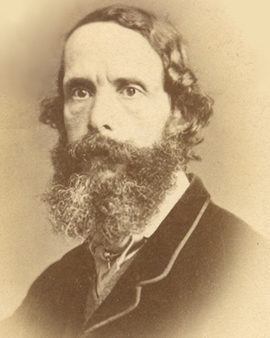


It can be a curse and a blessing at the same time to be born into a widely ramified family of artists. Edward Williams had six sons, and all of them became renowned landscape painters. They learned their craft from their father and preferred to paint the landscape around Barnes, a small town on the Thames near London. There their successful father had his spacious home and studio. At that time it was still quite rural there. Quiet swampland alternated with windmills, horses pulled the plough and rutted paths led past village inns or crossed shady valleys. This was the world of young Sidney Richard Percy Williams.
But how could he make his brand unmistakable? In 1841 he decided to give up his last name. From now on, from the age of 20, he called himself Sidney Richard Percy, a fully fledged scion of the Williams Family. He started his own family and moved to Buckinghamshire in 1863 with his wife Emily Charlotte and four children. There, too, the Thames remained characteristic of the landscape and was painted extensively by Percy. First successes were achieved. No wonder, one could say, with the ramified relations to the art world. Early on he exhibited at the Society of British Artists and also at the venerable Royal Academy. However, Sidney Richard Percy developed his own poetic style: he broke free from the shadow of the Williams Family and created uniquely atmospheric landscapes. The region around London became too narrow for him. He loved to roam the north of Wales, the counties of Devon and Yorkshire and the Lake District in search of expressive motifs. The changeable weather of the British Isles suited him well: Clouds tore open again and again, the sun flooded the landscape and shreds of clouds surrounded barren hills in the distance. In front of it, cows or fishermen tried their luck in a small lake. Percy's art was extremely successful, he owned carriages and a whole household of servants. But this did not leave him artistically exhausted. He especially liked to travel to the Scottish Highlands and the far northwest of Scotland, especially to the Isle of Skye, the largest island of the Inner Hebrides. Here the landscape was unspoilt, rough, barren and almost deserted. Percy created symbols of a sublime nature, in which the tiny human beings could feel at home.
Br/>
In 1865 he set off for mainland Europe with his friend William Callow. He travelled to Venice and on the way back to Switzerland and Paris, the German-Austrian War destroyed further travel plans. His career ended abruptly in 1886, when he was thrown from his horse and had to have one of his legs amputated. He died at the age of 64 from complications of this operation. The significant, vividly coloured style of his formidable natural landscapes made him immortal. And his children, of course, continued the legacy of the Williams-Percy family.

It can be a curse and a blessing at the same time to be born into a widely ramified family of artists. Edward Williams had six sons, and all of them became renowned landscape painters. They learned their craft from their father and preferred to paint the landscape around Barnes, a small town on the Thames near London. There their successful father had his spacious home and studio. At that time it was still quite rural there. Quiet swampland alternated with windmills, horses pulled the plough and rutted paths led past village inns or crossed shady valleys. This was the world of young Sidney Richard Percy Williams.
But how could he make his brand unmistakable? In 1841 he decided to give up his last name. From now on, from the age of 20, he called himself Sidney Richard Percy, a fully fledged scion of the Williams Family. He started his own family and moved to Buckinghamshire in 1863 with his wife Emily Charlotte and four children. There, too, the Thames remained characteristic of the landscape and was painted extensively by Percy. First successes were achieved. No wonder, one could say, with the ramified relations to the art world. Early on he exhibited at the Society of British Artists and also at the venerable Royal Academy. However, Sidney Richard Percy developed his own poetic style: he broke free from the shadow of the Williams Family and created uniquely atmospheric landscapes. The region around London became too narrow for him. He loved to roam the north of Wales, the counties of Devon and Yorkshire and the Lake District in search of expressive motifs. The changeable weather of the British Isles suited him well: Clouds tore open again and again, the sun flooded the landscape and shreds of clouds surrounded barren hills in the distance. In front of it, cows or fishermen tried their luck in a small lake. Percy's art was extremely successful, he owned carriages and a whole household of servants. But this did not leave him artistically exhausted. He especially liked to travel to the Scottish Highlands and the far northwest of Scotland, especially to the Isle of Skye, the largest island of the Inner Hebrides. Here the landscape was unspoilt, rough, barren and almost deserted. Percy created symbols of a sublime nature, in which the tiny human beings could feel at home.
Br/>
In 1865 he set off for mainland Europe with his friend William Callow. He travelled to Venice and on the way back to Switzerland and Paris, the German-Austrian War destroyed further travel plans. His career ended abruptly in 1886, when he was thrown from his horse and had to have one of his legs amputated. He died at the age of 64 from complications of this operation. The significant, vividly coloured style of his formidable natural landscapes made him immortal. And his children, of course, continued the legacy of the Williams-Percy family.
Page 1 / 1








